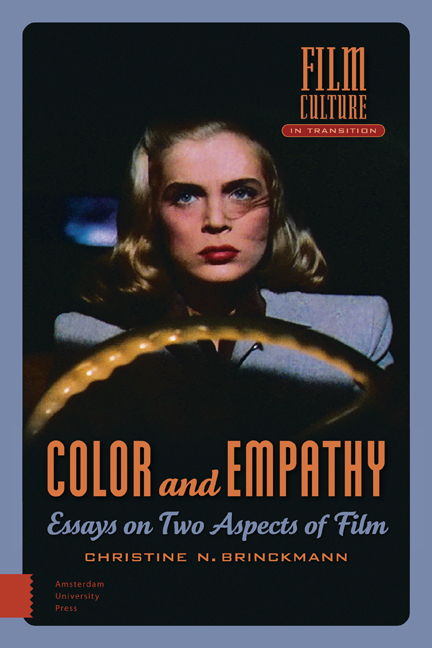Book contents
- Frontmatter
- Contents
- Preface
- Dedication
- Cinematic Color as Likeness and as Artifact: [2001]
- Chords of Color: [2006]
- The Tension of Colors in Colorized Silent Films: [2001]
- Structural Film, Structuring Color: Jenny Okun's Still Life: [1995]
- Desert Fury: A Film Noir in Color: [2012]
- The Work of the Camera: BEAU TRAVAIL: [2005]
- Empathy with the Animal: [1997]
- Motor Mimicry in Hitchcock: [1999]
- Abstraction and Empathy in the Early German Avant-garde: [1997]
- The Role of Empathy in Documentary Film: A Case Study: [2005]
- Genre Conflict in Tracey Emin’s Top Spot: [2007]
- Viewer Empathy and Mosaic Structure in Frederick Wiseman’s PRIMATE: [2009]
- CASTA DIVA: An Empathetic Reading: [2008]
- Publication Data
- Index of Films
- Index of Subjects
- Film Culture in Transition
Genre Conflict in Tracey Emin’s Top Spot: [2007]
Published online by Cambridge University Press: 23 June 2021
- Frontmatter
- Contents
- Preface
- Dedication
- Cinematic Color as Likeness and as Artifact: [2001]
- Chords of Color: [2006]
- The Tension of Colors in Colorized Silent Films: [2001]
- Structural Film, Structuring Color: Jenny Okun's Still Life: [1995]
- Desert Fury: A Film Noir in Color: [2012]
- The Work of the Camera: BEAU TRAVAIL: [2005]
- Empathy with the Animal: [1997]
- Motor Mimicry in Hitchcock: [1999]
- Abstraction and Empathy in the Early German Avant-garde: [1997]
- The Role of Empathy in Documentary Film: A Case Study: [2005]
- Genre Conflict in Tracey Emin’s Top Spot: [2007]
- Viewer Empathy and Mosaic Structure in Frederick Wiseman’s PRIMATE: [2009]
- CASTA DIVA: An Empathetic Reading: [2008]
- Publication Data
- Index of Films
- Index of Subjects
- Film Culture in Transition
Summary
Questions and method
My approach to this text began with two theoretical issues. One of them concerns the observation that we react differently to documentary persons or subjects than we do to characters in a fiction film. How can these differences be described, and what are the reasons for our genre-specific response? The other issue concerns the question of so-called F emotions (which result from fiction) and their potential conflict with A emotions (which result from the nature of a work as artifact). What happens if different kinds of response assert themselves simultaneously? And what happens to A emotions in non-fiction films? Can they be separated as neatly from empathetic reactions as they are in a fiction film?
As this terminology already reveals, my second question arose from a reading of Ed S. Tan's inspiring study Emotion and the Structure of Narrative Film. In tandem with Murray Smith's equally seminal book Engaging Characters, which came out almost simultaneously, this work has spawned a wealth of research on viewer response in the cinema. Both studies focus on the fictional film, but while Smith approaches the subject primarily from the discipline of narratology, Tan's approach is primarily a psychological one. And it is probably on account of this difference that both books can be fruitfully read back to back.
Tan's introduction of artifact emotions alongside fictional ones is particularly relevant to this essay. According to Tan, the source of A emotions is first of all an overarching interest in film as such: factors that elicit A emotions include formal aspects of rhythm or color that produce aesthetic pleasure; spectacular scenes and tours de force that trigger astonishment, or flawed passages to which one reacts with irritation. But whereas many scholars have elaborated on the differentiation of F emotions, A emotions have attracted little attention. Much still remains to be discovered.
The same lack of scholarly interest concerns the range of viewer responses to the nonfiction film. Astonishingly, research has remained within the terrain of Tan and Smith, focusing almost exclusively on the fiction film. The huge and rewarding field of the documentary and the so far only sketchily defined field of the personal, autobiographical, or experimental film have been widely neglected.
- Type
- Chapter
- Information
- Color and EmpathyEssays on Two Aspects of Film, pp. 199 - 220Publisher: Amsterdam University PressPrint publication year: 2014



